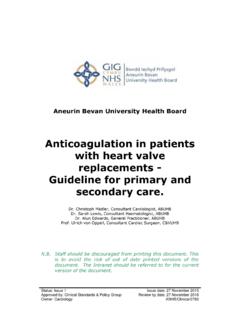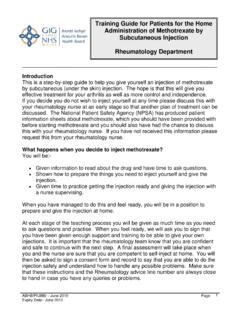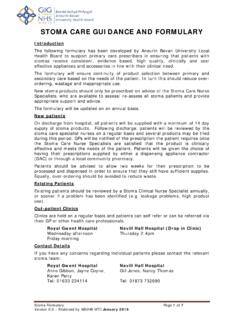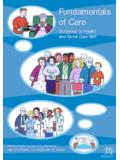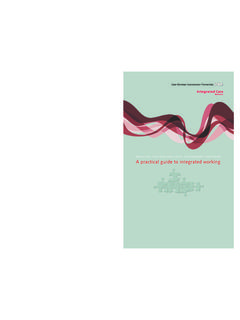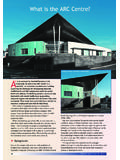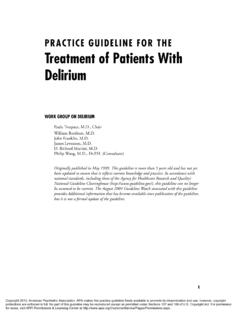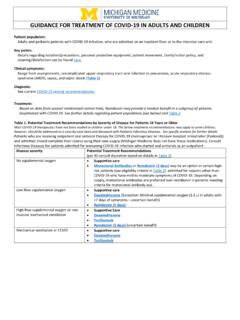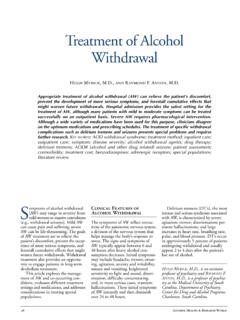Transcription of Delirium: diagnosis, prevention and management, NICE version
1 Issue date: July 2010. delirium delirium : diagnosis, prevention and management NICE clinical guideline 103. Developed by the National Clinical Guideline Centre for Acute and Chronic Conditions NICE clinical guideline 103. delirium : diagnosis, prevention and management Ordering information You can download the following documents from The NICE guideline (this document) all the recommendations. A quick reference guide a summary of the recommendations for healthcare professionals. Understanding NICE guidance' a summary for patients and carers. The full guideline all the recommendations, details of how they were developed, and reviews of the evidence they were based on. For printed copies of the quick reference guide or Understanding NICE. guidance', phone NICE publications on 0845 003 7783 or email and quote: N2224 (quick reference guide). N2225 ( Understanding NICE guidance'). NICE clinical guidelines are recommendations about the treatment and care of people with specific diseases and conditions in the NHS in England and Wales.
2 This guidance represents the view of NICE, which was arrived at after careful consideration of the evidence available. Healthcare professionals are expected to take it fully into account when exercising their clinical judgement. However, the guidance does not override the individual responsibility of healthcare professionals to make decisions appropriate to the circumstances of the individual patient, in consultation with the patient and/or guardian or carer, and informed by the summary of product characteristics of any drugs they are considering. Implementation of this guidance is the responsibility of local commissioners and/or providers. Commissioners and providers are reminded that it is their responsibility to implement the guidance, in their local context, in light of their duties to avoid unlawful discrimination and to have regard to promoting equality of opportunity. Nothing in this guidance should be interpreted in a way that would be inconsistent with compliance with those duties.
3 National Institute for Health and Clinical Excellence MidCity Place 71 High Holborn London WC1V 6NA. National Institute for Health and Clinical Excellence, 2010. All rights reserved. This material may be freely reproduced for educational and not-for-profit purposes. No reproduction by or for commercial organisations, or for commercial purposes, is allowed without the express written permission of NICE. Contents Introduction .. 4. Person-centred care .. 6. Key priorities for implementation .. 7. 1 Guidance .. 10. Think delirium .. 10. Risk factor assessment .. 10. Indicators of delirium : at presentation .. 11. Interventions to prevent delirium .. 12. Indicators of delirium : daily observations .. 14. Diagnosis (specialist clinical assessment) .. 15. Treating delirium .. 15. Information and support .. 17. 2 Notes on the scope of the guidance .. 18. 3 Implementation .. 19. 4 Research 19. Pharmacological 19. Pharmacological treatment.
4 20. Multicomponent intervention .. 20. delirium in long-term care .. 21. Education 22. 5 Other versions of this guideline .. 22. 6 Related NICE guidance .. 23. 7 Updating the guideline .. 24. Appendix A: The Guideline Development Group and NICE project team .. 25. Appendix B: The Guideline Review Panel .. 28. Appendix C: The algorithms .. 29. Introduction delirium (sometimes called acute confusional state') is a common clinical syndrome characterised by disturbed consciousness, cognitive function or perception, which has an acute onset and fluctuating course. It usually develops over 1 2 days. It is a serious condition that is associated with poor outcomes. However, it can be prevented and treated if dealt with urgently. A person may already have delirium when they present to hospital or long- term care or it may develop during a hospital admission or residential stay in long-term care. delirium can be hypoactive or hyperactive but some people show signs of both (mixed).
5 People with hyperactive delirium have heightened arousal and can be restless, agitated and aggressive. People with hypoactive delirium become withdrawn, quiet and sleepy. Hypoactive and mixed delirium can be more difficult to recognise. It can be difficult to distinguish between delirium and dementia and some people may have both conditions. If clinical uncertainty exists over the diagnosis, the person should be managed initially for delirium . Older people and people with dementia, severe illness or a hip fracture are more at risk of delirium . The prevalence of delirium in people on medical wards in hospital is about 20% to 30%, and 10% to 50% of people having surgery develop delirium . In long-term care the prevalence is under 20%. But reporting of delirium is poor in the UK, indicating that awareness and reporting procedures need to be improved. There is a significant burden associated with this condition. Compared with people who do not develop delirium , people who develop delirium may: need to stay longer in hospital or in critical care have an increased incidence of dementia have more hospital-acquired complications, such as falls and pressure sores NICE clinical guideline 103 delirium 4.
6 Be more likely to need to be admitted to long-term care if they are in hospital be more likely to die. This clinical guideline describes methods of preventing, identifying, diagnosing and treating delirium . In particular, the guideline focuses on preventing delirium in people identified to be at risk, using a targeted, multicomponent, non-pharmacological intervention that addresses a number of modifiable risk factors ( clinical factors'). If delirium is prevented, it should generate cost savings. This guideline does not cover children and young people (younger than 18. years), people receiving end-of-life care, or people with intoxication and/or withdrawing from drugs or alcohol, and people with delirium associated with these states. For more information see section 2 Notes on the scope of the guidance'. The guideline will assume that prescribers will use a drug's summary of product characteristics to inform decisions made with individual people.
7 NICE clinical guideline 103 delirium 5. Person-centred care This guideline offers best practice advice on the prevention of delirium in adults in hospital or long-term care who are at risk of delirium , and on the care of adults in hospital or long-term care who develop delirium . Treatment and care should take into account people's needs and preferences. People with delirium or at risk of delirium should have the opportunity to make informed decisions about their care and treatment, in partnership with their healthcare professionals. If people do not have the capacity to make decisions, healthcare professionals should follow the Department of Health's advice on consent (available from ) and the code of practice that accompanies the Mental Capacity Act (summary available from ). In Wales, healthcare professionals should follow advice on consent from the Welsh Assembly Government (available from ). Good communication between healthcare professionals and people in their care is essential.
8 It should be supported by evidence-based written information tailored to the person's needs. Treatment and care, and the information people are given about it, should be culturally appropriate. It should also be accessible to people with additional needs such as physical, sensory or learning disabilities, and to people who do not speak or read English. If the person agrees, families and carers should have the opportunity to be involved in decisions about treatment and care. Families and carers should also be given the information and support they need. NICE clinical guideline 103 delirium 6. Key priorities for implementation Risk factor assessment When people first present to hospital or long-term care, assess them for the following risk factors. If any of these risk factors is present, the person is at risk of delirium . Age 65 years or older. Cognitive impairment (past or present) and/or dementia1. If cognitive impairment is suspected, confirm it using a standardised and validated cognitive impairment measure.
9 Current hip fracture. Severe illness (a clinical condition that is deteriorating or is at risk of deterioration)2. Indicators of delirium : at presentation At presentation, assess people at risk for recent (within hours or days). changes or fluctuations in behaviour. These may be reported by the person at risk, or a carer or relative. Be particularly vigilant for behaviour indicating hypoactive delirium (marked *). These behaviour changes may affect: Cognitive function: for example, worsened concentration*, slow responses*, confusion. Perception: for example, visual or auditory hallucinations. Physical function: for example, reduced mobility*, reduced movement*, restlessness, agitation, changes in appetite*, sleep disturbance. Social behaviour: for example, lack of cooperation with reasonable requests, withdrawal*, or alterations in communication, mood and/or attitude. If any of these behaviour changes are present, a healthcare professional who is trained and competent in diagnosing delirium should carry out a clinical assessment to confirm the diagnosis.
10 1. If dementia is suspected, refer to further information on the diagnosis, treatment and care of people with dementia in Dementia: supporting people with dementia and their carers in health and social care' (NICE clinical guideline 42). 2. For further information on recognising and responding to acute illness in adults in hospital see Acutely ill patients in hospital' (NICE clinical guideline 50). NICE clinical guideline 103 delirium 7. Interventions to prevent delirium Ensure that people at risk of delirium are cared for by a team of healthcare professionals who are familiar to the person at risk. Avoid moving people within and between wards or rooms unless absolutely necessary. Give a tailored multicomponent intervention package: Within 24 hours of admission, assess people at risk for clinical factors contributing to delirium . Based on the results of this assessment, provide a multicomponent intervention tailored to the person's individual needs and care setting as described in recommendations The tailored multicomponent intervention package should be delivered by a multidisciplinary team trained and competent in delirium prevention .
